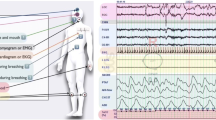Abstract
Obstructive sleep apnea syndrome (OSAS) is characterized by repeated cessations of breathing during sleep. Major symptoms of this disease are excessive daytime sleepiness, snoring, and witnessed apnea. Most of the patients are treated with CPAP. In this study, we aimed to evaluate the factors affecting adherence to the CPAP treatment. Seventy-one patients were enrolled to this study. Patients were divided into three groups according to CPAP usage. Group I consisted of patients who had never used CPAP, group II consisted of patients who had used CPAP occasionally, and group-III patients had used CPAP treatment regularly. Group-III patients had higher apnea–hypopnea index (AHI) than groups I and II (respectively, 56.6 ± 27.7, 26.3 ± 7.5, and 32.3 ± 7.06; p < 0.000 for both). Oxygen desaturation index was significantly higher in group-III patients comparing to groups I and II (44.6 ± 22.3, 15.9 ± 8.3, and 25.6 ± 9.5; p < 0.000 for all). Our findings have shown that only very severe patients use the CPAP device regularly (mean AHI 56.6 ± 27.7). Compliance to CPAP treatment seemed to be poor in patients with moderate to severe, AHI about 30, OSAS. Considering the well-established benefits of CPAP treatment in patients with true indications, patients should be encouraged to use CPAP regularly, and complications of OSAS should be keynoted.
Similar content being viewed by others
References
Sanders MH (2005) Sleep breating disorders. In: Kryger MH, Roth T, Dement WC (eds) Principles and practice of sleep medicine. 4th edn. Elsevier, Amsterdam, pp 969–1121
Masood A, Phillips B (2000) Sleep apnea. Curr Opin Pulm Med 6:479–484
He J, Kryger MH, Zorick FJ, Conway W, Roth T (1988) Mortality and apnea index in obstructive sleep apnea: experience in 385 male patients. Chest 94:9–14
Kakkar RK, Berry RB (2007) Positive airway pressure treatment for obstructive sleep apnea. Chest 132:1057–1072
Janson C, Noges E, Svedberg-Brandt S, Lindberg E (2000) What characterizes patients who are unable to tolerate continuous positive airway pressure (CPAP) treatment. Respir Med 94:145–149
Johns MW (1991) A new method for measuring daytime sleepiness. Sleep 14:540–545
American Academy Of Sleep Medicine (1999) Sleep-related breathing disorders in adults: recommendations for syndrome definition and measurement techniques in clinical research. The report of an American Academy of Sleep Medicine task force. Sleep 22:667–689
Hoffstein V (2007) Review of oral appliances for treatment of sleep-disordered breathing. Sleep Breath 11:1–22
Prinsell JR (2002) Maxillomandibular advancement surgery for obstructive sleep apnea syndrome. J Am Dent Assoc 133:1489–1497
American Thoracic Society Official Statement (1994) Indications and standards for use of nasal continuous positive airway pressure (CPAP) in sleep apnea syndrome. Am J Respir Crit Care Med 150:1738–1745
Polo O, Berthon-Jones M, Douglas NJ, Sullivan CE (1994) Management of obstructive sleep apnoea/hypopnoea syndrome. Lancet 344:656–660
Kawahara S, Akashiba T, Akahoshi T, Horie T (2005) Nasal CPAP improves the quality of life and lessens the depressive symptoms in patients with obstructive sleep apnea syndrome. Intern Med 44:422–427
Fidan F, Unlu M, Sezer M, Gecici O, Kara Z (2007) Compliance to CPAP treatment and effects of treatment on anxiety and depression in patients with obstructive sleep apnea syndrome. Tuberk Toraks 55:271–277
Author information
Authors and Affiliations
Corresponding author
Rights and permissions
About this article
Cite this article
Yetkin, O., Kunter, E. & Gunen, H. CPAP compliance in patients with obstructive sleep apnea syndrome. Sleep Breath 12, 365–367 (2008). https://doi.org/10.1007/s11325-008-0188-4
Received:
Revised:
Accepted:
Published:
Issue Date:
DOI: https://doi.org/10.1007/s11325-008-0188-4




